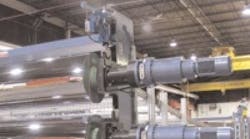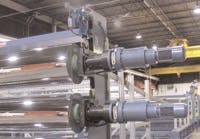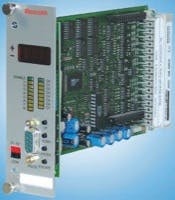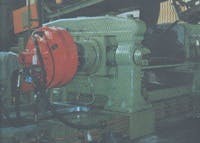Better gap control improves quality and speed
Welex Corp., Blue Bell, Pa., a maker of extrusion equipment, is known worldwide for its sheet extrusion lines that serve packaging and other markets with product widths from 30 in. to more than 10 ft andcapacities to more than 4 tons/hr. Welex engineers recently developed an improved system for controlling the gap in its sheet take-off system. After polymer material passes through extrusion dies that give the sheet its basic shape, it passes to take-off rolls. The rolls cool the material, form the sheet to the desired thickness and surface finish, and accumulate the sheets in uniform rolls or flat stacks. Sheet thicknesses range from 0.004 in. to more than 1.5 in.
The 24-in. diameter take-off rolls rotate at 48 rpm and achieve maximum heat transfer with minimal roll deflection under load. The rolls have a double-shell construction, with multiple spiral baffles to ensure high cooling fluid velocity for uniform roll temperatures. A heavy rigid inner shell supports a shrunkfit outer shell. To prevent deflection from high sheet pressure, rolls are constructed with a thick, hard, stainless steel overlay.
Critical characteristics
Proper cooling requires just the right roll diameter. If roll diameter is too small, line capacity will be limited. If roll diameter is too large, the sheet may not lie flat after cooling or excessive sheet sagging may occur between the die and roll.
The gap between the rolls is also critical. The system uses three rolls — top, middle, and bottom. The middle roll is fixed, and the upper and lower rolls move vertically to create the proper gap. The top roll must maintain a fixed gap between it and the center roll to achieve the proper sheet thickness. The bottom roll, which provides the final polish and surface finish, is also set to a gap, but is allowed to float based on a force setting. The float is necessary to prevent ripples from forming on the sheet.
Improvement through electrohydraulics
Welex engineers wanted to upgrade the system so it could automatically control the roll gaps. Its analog electrohydraulic control system, in use since 1991, required a custom electrical control to interface with the overall machine controls. Engineers had built a custom conversion box, which required multiple adjustments during startup. In addition, the hydraulic system's servovalves were sensitive to contamination, so expense and effort was required to keep hydraulic fluid clean.
However, the biggest drawback, according to Mike Mitchell, Welex's director of engineering, was that the system could only control the position of the rolls, not the applied force. "We wanted to sense both the position of the roll and the force being exerted on the sheets. Although the position of the roll is a good indicator of the gap, being able to also monitor the force and make on-the-fly adjustments gives us even better results in sheet quality." The machines require controlling forces to 40,000 lb at lines speeds of 300 ft/min. Naturally, radial roll force can easily be calculated from fluid pressure differential across the hydraulic cylinders actuating them.
Distributor involvement
Mitchell explained the drawbacks of the existing system and explained his vision of an improved system to Gary Jermyn, a fluid power specialist at Airline Hydraulics, Bensalem, Pa., a value-added distributor for Bosch Rexroth. Jermyn enlisted the aid of Neal Gigliotti, an applications engineer at Bosch Rexroth specializing in the plastics industry. The system Jermyn and Gigliotti proposed to Welex uses a VT-HACD digital hydraulic axis controller to monitor and control movement of the two outer rolls. The system provides precise control based on both position and/or force through a pair of Bosch Rexroth CST4 hydraulic servo cylinders.
Two control loops interact with one another. The closed-loop position controller sets the basic gap required. The closed-loop force controller monitors the hydraulic pressure and limits the amount of force exerted on the roll. This force limiting function allows the roll to float on the surface of the plastic sheet, thereby producing the desired surface finish.
Because each roll is a highvalue, precision-manufactured component, damage to a roll not only halts production, but represents a costly repair involving considerable downtime. The closedloop hydraulic force control system automatically reacts to any obstruction within the material. An obstruction would produce a sudden increase in pressure, which would cause the control to open the rolls to allow the obstruction to pass through. The cylinder would then return to the proper setting once the obstruction had passed.
The VT-HACD controller and CST4 cylinder together can control the gap with impressive 0.0001-in. accuracy over a 5-in. travel. As Mitchell explained, "Manual gap control is a tedious trial-and-error process using feeler gauges and handwheel adjustments. The new system gives us control of the gap with greater precision than can be obtained manually."
Technology that gets it done
The VT-HACD digital axis controller offers four servo axes to control movement of the rolls. Each end of each of the two movable rolls forms one axis. Coordination at each end is required to ensure that the rolls remain parallel with a consistent gap across the span. Any skew can turn production into scrap.
The controller monitors the four axes and provides on-the-fly adjustment in milliseconds. Setpoints and data are transferred between the axes and the machine's PLC over a PROFIBUS network. Gigliotti explains, "The HACD is user configurable through a Windows-based graphical interface using pull-down menus, check boxes, and value fields. There is no programming language to master, so a system designer can configure the controller in only a few hours." Indeed, the first Welex system was up and running in less than a day.
The hydraulic system itself is powered by a single Bosch Rexroth A10VSO pump, which can deliver 81⁄2 gpm at pressure to 3000 psi in this application. In addition to the four cylinders, the pump supplies fluid to an accumulator. The accumulator supplements pump flow when short-duration peak flow is needed. It also serves as an emergency power source to fully open the roll gap should electrical power be lost.
Smart cylinders are essential
The CST4 hydraulic servo cylinders play a critical role in achieving the precision movements required. Each of the cylinders has a 4-in. bore, 5-in. stroke, 13⁄4-in. piston rod, with its respective proportional control valve mounted directly on it. Airline's Jermyn notes, "The closer you can bring the valve to the cylinder, the quicker and more accurate the response you can achieve. In addition, a digital position feedback transducer is inside the cylinder, where it is rigidly mounted and protected from damage." The integration of feedback device, valve, and cylinder into one unit offers compact design and quick installation.
Also critical to high accuracy positioning are the low-friction seals in the cylinders. Gigliotti explains that standard piston seals generally exhibit stiction — stickslip operation. This occurs because a typical piston seal's static friction is higher than its dynamic friction. When the piston begins to move, the seal will flex instead of slide. As the piston moves further, the static friction between seal and cylinder is overcome, and the seal slides, snapping back to the original shape. If the static friction is high enough, the piston will overshoot the intended position.
"Stick-slip presents no problems if you're talking about small errors within the allowable tolerances of an application, but for accuracies of ten-thousandths of an inch, you need to absolutely minimize stick-slip by using low-friction seals," says Gigliotti.
Exceeding expectations
The new system exceeded the requirements of Welex in terms of both performance and logistics. Welex's Mitchell said that the new system gives Welex several advantages in deploying an improved takeoff system. "The new roll-gap control is built entirely from offthe-shelf components, all from a single source. We eliminated any custom components — including the custom electronics we needed for the previous system. In addition, having all components from a single supplier gives a single point of accountability. The components integrate easily and flawlessly."
For additional information, visit www.boschrexroth-us.com or email Neal Gigliotti at neal. [email protected].
The direct approach
Pre-kneaded crude rubber and plastics are homogenized, mixed, broken-down, pre-heated and rolled out in mixing mills. The mixing effect is achieved through friction in the gap between parallel, counter-rotating rollers, which also rotate at different speeds. Different materials call for different friction ratios, so electromechanical drives often prove impractical because of the need for high torque combined with variable speed .
Low-speed, high-torque (LS/HT) hydraulic motors generally provide the best solution for this application. However, direct-drive hydraulic motors, from Hagglunds Drives, Columbus, Ohio, go one step better by offering a compact solution with motors that mount directly to the roll shafts. No intermediate gearboxes are needed, nor is bulky mounting framework. This is because the motors have a hollow output shaft, so they mount directly onto the end of each roll shaft. All that's needed is a torque arm to prevent the motor housing from rotating.
Multiple benefits
The main advantage of these radial-piston motors is their compact, simple design. Plus, the hydraulic power unit can be located away from the roll mill, thereby reducing installation space requirements even more. But the list of advantages goes on. The motor's low inertia makes it possible to stop the rolls immediately, so there is no need for mechanical brakes. Plus, the motors exhibit high starting torque, so they can rotate the shafts from a standstill even when material is cold.
The motors' low inertia also improves safety. For example, a mixing roll 660 mm (26 in.) in diameter, rotating at 16 rpm can be stopped in a peripheral distance of less than 30 mm (11⁄4 in.). This is because these types of drive motors are low inertia drives without gears or gearboxes. When needed, an emergency stop valve fitted directly to the motor can provide additional braking, eliminating the need for mechanical brakes. Noise can also be substantially lower with the direct gearless drives.
Standard motors are available with power ratings to 750 kW continuous and 1500 kW intermittent.
For more information, call (614) 527-7400 or visit www.hagglunds.com





